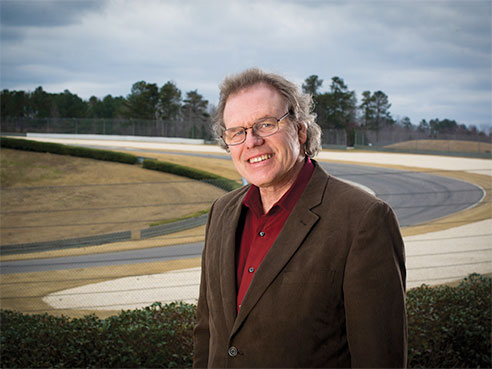Need more information? Contact us
 For more than a decade, the SAFER Barrier developed by UAB’s Dean Sicking, Ph.D., has proved its lifesaving ability at NASCAR and IndyCar circuits across the United States. This year, the device is going international.
For more than a decade, the SAFER Barrier developed by UAB’s Dean Sicking, Ph.D., has proved its lifesaving ability at NASCAR and IndyCar circuits across the United States. This year, the device is going international.
The SAFER — Steel and Foam Energy Reduction — Barrier is making its European debut at the historic circuit in Le Mans, France, site of the world’s oldest active endurance racing event, the 24 Hours of Le Mans.
Sicking, a mechanical engineering professor and researcher at the UAB School of Engineering, says the installation of his product at Le Mans is significant in that it marks the first time a racing facility has performed an independent evaluation of two competing barrier systems. Earlier renovations to the Le Mans circuit in 2014 installed TechPro barriers, a fundamentally different type of barrier system.
“We are very pleased that Le Mans is installing the SAFER Barrier because we believe it validates what we already know: that our barrier is the best option to improve driver safety,” Sicking said.
The effect of SAFER Barriers has been apparent in American auto racing over the past decade. The deaths of high-profile drivers such as Adam Petty in 2000 and Dale Earnhardt in 2001 led to a push for safety modifications that resulted in SAFER Barriers’ being installed at every IndyCar and NASCAR course by 2005. Since then, there have been no fatal wall crashes in those events. In fact, drivers, such as ARCA racer Brad Smith, have survived horrific crashes at full throttle — impacts that almost certainly would have been fatal prior to the barrier’s installation.
The Circuit de la Sarthe has been home to the 24 Hours of Le Mans since 1923. The Porsche Curves have been a feature on the western end of the circuit since 1972. By adding the SAFER Barrier to the first curve, track officials were able to avoid modifications that would have altered the layout of the course.
Rather than an oval circuit like Daytona or Talladega, the circuit at Le Mans is an irregularly winding road course. The area of the circuit where the SAFER Barrier is installed is called the “Porsche Curves,” a series of curves that come at the end of a long straightaway.
SAFER Barriers from uabnews on Vimeo.
“The first curve is the most dangerous because it is coming off of that straightaway,” Sicking explained. “Even if the driver slows down coming into the curve, the vehicle will approach at a steep angle. The increased angle and the speed work together to make the total impact much more severe.”
Often referred to as a “soft wall,” the SAFER Barrier does more than soften the landing.
“Our barrier is designed to separate the impact into two separate events,” Sicking said. “Each impact involves a change in velocity of roughly one half the impact speed, which allows the barrier to work in tandem with the car’s safety devices. The decreased impact speed effectively means the car is hitting the barrier at half speed, and at half speed, the safety devices built into the car are more than adequate to protect the driver.”
Devotion to driver safety — both on the racecourse and on the highway — has been a defining characteristic of Sicking’s career. Whether it is SAFER Barriers to stop high-speed racecars or guardrail terminals to catch wayward station wagons, Sicking’s inventions take advantage of basic engineering principles to save lives.
“Barriers are designed to stop vehicles, but we have the ability to design them so the barrier absorbs the impact of the crash. If that energy is not absorbed by the barrier, it is absorbed by the car and subsequently the car’s occupants. In some cases, that can mean the difference between a fatality and walking away from a crash uninjured.”